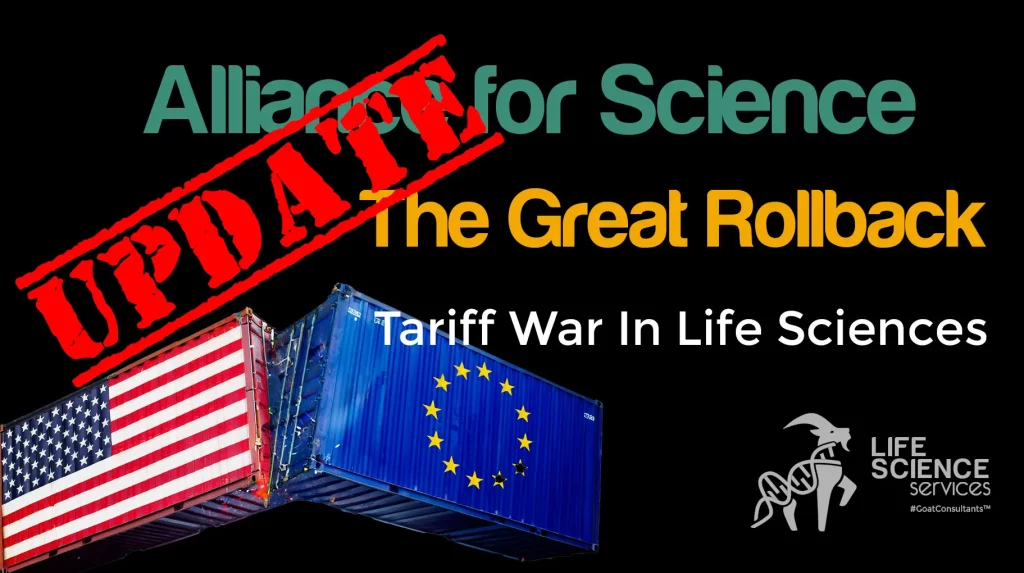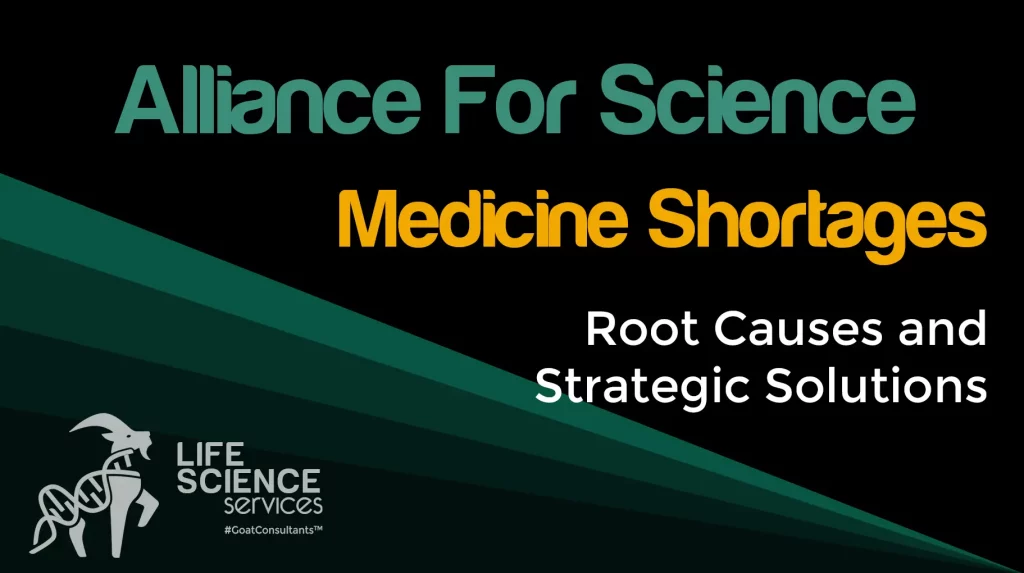What AI Can’t Do In An ERP Migration

What AI Can’t Do In An ERP Migration
AI can crunch data fast but it can’t align teams, resolve conflicts, or drive adoption. That’s where an ERP Transition Manager steps in. They translate chaos into clarity, bridging strategy and execution to ensure your ERP upgrade actually delivers.
Latest News On Tariffs In Life Sciences

The latest news on tariffs in life sciences reveals rising costs, policy risks, and innovation threats. Here’s what executives must know, and do, to stay ahead.
Trump’s Biotech Policy Is Reshaping Global Science and Pharma Supply Chains

Trump’s biotech policy is reshaping global pharma through tariffs, pricing reforms, and reshoring mandates. It is forcing life sciences leaders to rethink innovation, supply chains, and strategy.
Tariff Exemptions in Life Sciences – A Closer Look at the April 2025 Update

🚨 Tariff Exemptions in Life Sciences
❌ Trade policy is failing U.S. pharma & biotech manufacturing.
✅ 60% of pharma inputs & medicines are now tariff-exempt.
❌ But when considering the entire life sciences industry, that number drops to 40%.
🔻 What’s missing?
❌ Medical devices are NOT included.
❌ Manufacturing equipment (CAPEX) is still taxed.
❌ Key biomanufacturing consumables face tariffs.
💡 The biggest contradiction?
Trump’s administration says it wants to “re-arm” U.S. industry—but tariffs still apply to the equipment needed to manufacture medicines here.
👉 How can companies bring production back if CAPEX remains expensive?
📢 What needs to change?
🔹 Exempt medical devices & biotech consumables.
🔹 Eliminate CAPEX tariffs to allow true reshoring.
🔹 Create a comprehensive trade policy for ALL life sciences.
Right now, this isn’t an industrial revival—it’s a half measure.
Licensing Agreements In Life Sciences Amidst Trade Wars and Regulatory Shifts

The Great Rollback is disrupting licensing agreements in life sciences as trade wars and regulatory fragmentation create uncertainty. FDA instability is delaying approvals, causing licensing disputes, while U.S. export controls are forcing European biotechs to reconsider partnerships. To mitigate risks, companies are embedding ‘trade war triggers’ and arbitration clauses in agreements. Meanwhile, the EMA’s regulatory stability offers a strategic advantage, enabling U.S. and Chinese firms to prioritize Europe for faster approvals and market entry. The future of licensing will depend on adaptability, geopolitical foresight, and leveraging EMA’s reliability.
Tariff War In Life Sciences: How to Manage Customs Risks and Costs

The U.S.-EU tariff war is raising costs and tightening customs scrutiny for pharmaceuticals, medical devices, and IMPs. With 25% tariffs on exports, companies can no longer rely on nil-value declarations for clinical trial shipments, risking higher costs, delays, and compliance issues. To navigate this, firms must adopt ERP-driven customs management, ensuring accurate HTS classification, tariff tracking, and duty mitigation to protect supply chains and control costs.
Medicine Shortages in the EU: Root Causes and Strategic Solutions

Medicine shortages in the EU are not a new challenge, yet they continue to disrupt healthcare systems and patient care worldwide. Over 50% of these shortages stem from manufacturing and quality issues, exacerbated by fragmented supply chains, inadequate data management, and reactive crisis handling.
This article dissects the root causes of medicine shortages and offers practical, data-driven solutions for life sciences companies. From strengthening supply chain resilience to leveraging modern ERP systems for early risk detection, we explore how small and mid-tier pharma companies can move from crisis response to proactive prevention.
The key to solving medicine shortages? Organized data, structured processes, and strategic action. Read on to discover how the right approach can transform uncertainty into stability.
Key Financial Focus for Life Sciences in 2025: The Five Pillars of Financial Excellence

In 2025, finance teams in small and mid-tier life sciences companies are transitioning from traditional roles to become enablers of innovation. This evolution is guided by five key pillars:
1. Capital Allocation: Prioritizing strategic planning to balance cost efficiency with investment in high-return areas, ensuring sustainable growth.
2. Diversifying Revenue Streams: Reducing reliance on single income sources by exploring licensing deals, partnerships, and geographic expansion to mitigate market volatility.
3. Mergers & Acquisitions Trends: Adapting to M&A landscapes influenced by GenAI and ESG priorities, requiring agile strategies and leveraging niche expertise to stay competitive.
4. Regulatory and ESG Compliance: Proactively integrating stringent regulatory requirements and robust ESG practices to build trust and long-term value.
5. Digital Transformation and AI: Embracing AI-driven insights and automation to eliminate inefficiencies, allowing finance teams to focus on strategic initiatives.
By focusing on these pillars, finance teams can effectively navigate the evolving landscape of the life sciences industry in 2025.
Leveraging Digital Transformation and AI for Financial and Operational Efficiency in 2025

In 2025, digital transformation and AI are fundamentally reshaping financial and operational landscapes in the life sciences sector. CFOs and executives in pharma, biotech, medtech, and biopharma are adopting strategic approaches to navigate these changes effectively. Key priorities include automating routine tasks to free up resources for strategic activities, leveraging real-time data analytics for informed decision-making, integrating cloud-based ERP solutions with AI tools for scalability and continuous innovation, and enhancing cybersecurity measures to protect sensitive data. Effective data management is crucial, as AI’s success depends on accurate, complete, and structured data. Investing in robust data governance frameworks ensures data quality and integrity, positioning businesses for long-term success in this evolving landscape.
Future of Healthcare 2025: Mastering Regulatory Landscapes

Regulatory shifts and ESG integration are reshaping life sciences. The EU Data Act (Sept 2025) mandates easier access to user-generated data, while the Biotech Act enforces stricter guidelines for gene therapy and personalized medicine in both the EU and US. ESG principles are now essential for investor trust and long-term growth. To stay competitive, companies must embrace compliance, sustainability, and digital transformation.
How Small and Mid-Tier Life Sciences Companies Can Shape M&A Trends in 2025

In 2025, small and mid-tier life sciences companies are significantly influencing mergers and acquisitions (M&A) by leveraging innovation, flexibility, and niche expertise. These agile firms excel in developing cutting-edge therapies and technologies, particularly in specialized markets like rare diseases and personalized medicine, making them attractive partners for larger organizations. Their ability to adopt creative deal structures, such as revenue-sharing models and joint ventures, allows for scalable growth without full integration. Additionally, the use of AI-driven tools in due diligence processes enhances transparency and accelerates deal execution, setting new industry standards. By embracing these strategies, small and mid-tier companies are not only attracting lucrative deals but also redefining M&A dynamics in the life sciences sector.
Diversifying Revenue Streams Beyond Core Products

In an increasingly competitive life sciences landscape, CFOs of small and mid-cap pharma and biotech companies are strategically diversifying revenue streams to address patent cliffs and market uncertainties. This shift goes beyond risk mitigation to ensure sustainable growth and innovation. From digital health technologies to strategic alliances, diversification has become critical for success in 2025. Companies are moving beyond traditional drug development to explore digital therapeutics, AI-driven diagnostics, and personalized medicine solutions. This evolution is especially vital for smaller players competing with larger pharmaceutical companies. Through diversification, companies protect against market volatility while driving healthcare innovation. Digital technologies and strategic partnerships create new opportunities in the evolving healthcare landscape.
Capital Allocation and Cost Efficiency in Life Sciences

Small and mid-cap life sciences companies face mounting pressures in 2025. With increasing market volatility, limited resources, and fierce competition, many CFOs are struggling to direct capital allocation and cost efficiency effectively. Inefficient capital allocation not only slows innovation but can also lead to missed growth opportunities, delayed product launches, and financial instability. If left unresolved, these challenges could jeopardize strategic priorities, reduce shareholder confidence, and compromise long-term sustainability. For companies in biotech, pharma, and biopharma, the stakes are especially high as competition intensifies and access to funding tightens. CFOs must act decisively to align resources with business goals and ensure efficient financial operations.
Mastering Licensing Agreements Financial Management for Life Sciences Success

Effective financial management of licensing agreements is crucial for small and mid-tier life sciences companies, as these agreements provide essential funding and strategic collaboration opportunities. To navigate the complexities of licensing, companies should adopt best practices such as aligning milestone payments with key value-driving events like clinical trial successes, tailoring royalty structures to market realities through tiered models, and leveraging modern ERP systems. These systems offer integrated project management and real-time tracking of milestones and costs, enhancing transparency and efficiency. By implementing these strategies and utilizing advanced financial tools, companies can foster innovation, mitigate risks, and build partnerships that drive the development of life-changing therapies.
Is Finance The Weak Link in Biotech Innovation?

In 2025, financial innovation is pivotal for small and mid-tier life sciences companies aiming to navigate complex licensing agreements effectively. Implementing modern Enterprise Resource Planning (ERP) systems is essential, as they centralize data, automate tasks, and integrate AI capabilities, thereby enhancing financial operations. By adopting best practices and leveraging technology, companies can build partnerships that foster innovation, mitigate risks, and deliver life-changing therapies to patients worldwide.
Poor Cash Flow Reporting Holds Back Life Sciences Innovation

Finance teams in small to mid-cap pharma and biotech face complex cash flow management issues under both US GAAP and IFRS. Cash flow statements often reveal a troubling gap: they lack the actionable insights needed for strategic decisions. In an industry where every dollar counts, failing to address these limitations jeopardizes a company’s financial agility and its survival. Major pain points include the pressure to classify cash flows accurately as operating, investing, or financing activities, and the added complexity of foreign currency transactions due to fluctuating exchange rates. Mergers and acquisitions further complicate reporting, requiring precision in separating acquisition-related expenses and liabilities. Additionally, transactions like contingent considerations and stock compensation arrangements bring unique challenges in presenting clear and accurate cash flows, often leading to confusion and restatements.
The Value of Your Company Unveiled Thanks to Modern ERP Financial Reporting

In small and mid-cap life sciences companies, finance teams are stuck in legacy accounting practices that stifle innovation. Bloated Excel sheets, convoluted explanations, and feedback loops that feel more like interrogations leave R&D teams frustrated and distracted. These outdated processes don’t just waste time—they erode the value of R&D itself. It’s time for non-finance leaders to demand streamlined, transparent tools that support growth, not block it.
As a result, the journey from lab to market hinges on the seamless integration of R&D with strategic financial oversight.
Below, we explore why CFOs – and stakeholders – must rethink their approach, replacing outdated methods with more modern and integrated solutions to protect and amplify R&D success.
Outdated Accounting Practices Hold Back R&D Success

In small and mid-sized life sciences companies, outdated accounting methods in finance are causing more harm than meets the eye. Legacy systems—marked by complex Excel spreadsheets and lengthy feedback loops—are overwhelming R&D teams. These inefficient practices waste time and drain the value of R&D, leading to delays in innovation. It’s time for non-finance leaders to push for streamlined, transparent accounting tools that drive progress rather than hinder it. The path from lab to market depends on integrating R&D with modern, strategic financial oversight. CFOs and stakeholders must embrace up-to-date, integrated solutions to secure R&D success and company growth.
Outdated Accounting Processes Hinder Revenue Recognition Efficiency

Outdated accounting processes in small and mid-sized life sciences companies significantly hinder revenue recognition efficiency. Reliance on legacy systems and manual methods leads to inaccuracies and delays, especially when scaling operations. To address these challenges, companies should modernize their financial processes by implementing advanced ERP systems and adopting automation. These changes will improve accuracy, efficiency, and scalability, ensuring compliance with revenue recognition standards like ASU 2014-09 and IFRS 15. By upgrading systems, companies can streamline revenue recognition, ensure compliance, and drive growth. 
Shipping IMPs for Clinical Trials in Europe: Best Practices

Shipping Investigational Medicinal Products (IMPs) for clinical trials in Europe is a critical yet complex process. IMPs, being unapproved drugs used in clinical trials or Early Access Programs (EAPs), require meticulous handling to navigate customs regulations, value-added taxes (VAT), and specific local requirements. Common mistakes in this process can lead to significant delays and increased costs. To avoid these pitfalls, it’s essential to understand and adhere to best practices, ensuring compliance and efficiency in the supply chain. For a comprehensive guide on these practices, refer to the full article.
Strategic Success Framework – The Rule of Threes

This framework emphasizes the three critical elements for sustainable success in the biopharmaceutical industry:
1. **Key Objectives for Growth**: Focus on maximizing pharmaceutical innovation returns, enhancing patient engagement strategies, and developing internal digital skills.
2. **Organizational Purpose Strategies**: Establish long-term goals, maintain stakeholder connections, and utilize employee talents effectively.
3. **Critical Focus Areas**: Advance research and development, create value for stakeholders, and prioritize people within the organization.
The framework aims to balance technological advancements with fundamental principles, ensuring companies can thrive by delivering value to patients, shareholders, and employees.
Benefits of SAP Business ByDesign ERP for Life Sciences companies

In a rapidly evolving biotech industry, SAP Business ByDesign ERP provides a flexible and scalable solution to overcome limitations, streamline operations, and support informed decision-making with real-time data. It helps companies implement industry best practices at a competitive cost, offering clear dashboards useful for cooperation, publications, and real-time presentations. The system eliminates the need for management to spend days assembling data for presentations. In the life sciences industry, SAP ByDesign offers efficient and integrated project management with real-time dashboards to track progress and identify risks. R&D costs are captured using multiple GAAP requirements for management reporting, statutory filings, and tax books. Specific configuration by asset contributes to a clear, auditable, and real-time valuation of the asset. Leading SaaS companies in the life sciences industry, particularly in lab management and validation, have specific applications that integrate easily thanks to the “click not code” concept. SAP Business ByDesign ERP is highly valued by investors and plays a decisive role in acquisitions and mergers because of its compliance and risk management modules, making it a must-have for best practices.
CxOs challenges for 2023 in the Life Sciences sector

In this article, we’ll explore some of the key trends that will shape the life sciences industry for the next years to come (2023 and beyond). We examined how companies are responding to these new needs, and what CxOs can do to stay competitive as these trends develop in every business function. The life sciences sector is under perpetual transformation. When we published our first article in November 2017 (see the article here), the need for innovation, digitalization and AI were impacting only support functions such as finance and HR. The COVID-19 pandemic accelerated the digital conversion, companies largely adopting the cloud but its benefits for organizations remain uncertain. If it wasn’t for COVID-19, many companies probably wouldn’t have converted to cloud. Companies are evolving slowly to the digital era. But why? A more holistic approach is needed by setting long-term strategic digital objectives across business and core functions. Internal metrics to benchmark digitalization investments are a must. Knowing the Business Value and ROI requires to assess and identify where digital capabilities could be scaled more effectively. What is next? Focus on Patients, (lots of) Data, Predictivity, Agility and Resilience! To be attractive to investors and remain competitive, companies must scale digitalization. The objective is not anymore to reach “agility” it is to meet the demand of regulators and patients. Regulators require companies to use data more widely and efficiently throughout the lifecycle of a medicine, from preclinical development, through the clinical trial process, and into real world. Recent studies demonstrated that hybrid clinical trial models, mixing digital and face-to-face interactions, highly increase patient engagement and focus. It allows to better understand patient preferences during the evaluation process and make clinical development and regulation more cost-effective. On the strategic side, the ability to detect and execute alternative scenarios to disruptive events and business opportunities, will be key. Companies cannot rely on one scenario and one-forecast model. CxOs must focus on offsetting higher costs by exploring different strategies and new paths for liquidity and growth while implementing actionable plans to increase return on pharmaceutical innovation (RPI) and productivity. Every business function is required to be transparent and participate in producing insights to enhance the patient experience, increase the value chain, from molecule development to commercialization. The following is our review about the 8 areas of what life sciences companies need to focus as they prepare for 2023 and beyond. 1) Patient Experience The strategic priority is to develop patient services and cover more than access to therapy and engagement such as funding. Investments in patient-centric digital capabilities to build around patience experience, will help anticipate needs and expectations thanks to predictive measures built on the analysis of patients’ data. 2) Drug Development To stay ahead of the curve, companies must focus on reducing costs to bring an asset to the market to improve the return on pharmaceutical innovation (RPI). Hybrid clinical trial models highly contribute to cut costs, while accelerating completion of the trial and supports patients’ engagement. Another option to improve RPI is to co-develop assets. Novel therapeutic platforms can accelerate development of priority therapeutic areas (rare diseases and gene editing technologies), but they remain expensive and complex to develop. Collaborations and scientific partnerships are a great way to reduce costs and improve performances. The rise of AI and machine learning tools to analyze data also contribute to improve trial designs, including recruitment of more diverse patients, which is also material for ESG (see point 5 below), and addresses regulators’ requirements in terms of Real-world data (RWD) and Real-world evidence (RWE) data. Finally, data management has become increasingly complex as more stakeholders become involved in clinical trials and other aspects of R&D. This creates challenges for companies trying to make sense of the data they collect while also protecting patient privacy rights under GDPR regulations. 3) Regulatory (excluding local policies changes). Companies should accelerate the integration of science and technology in medicines development. Regulators require more evidence which cannot all come from clinical trials. Thanks to digital collaboration, demonstrating real life value, starting from R&D and thru increase patient involvement, will participate to gathering more collaborative evidence generation for better scientific quality of evaluations by the regulators. Enabling collaboration with healthcare systems as early as possible, by considering rolling reviews which can be considered outside of public health emergency. 4) Supply Chain Supply chain disruptions will reach levels never seen before in 2023 thus secure multi-sourcing capabilities is key as well as delivering products on time will keep high customers confidence and trust. The procurement function will become central to detect and prevent disruptions: 5) Environmental, Social and Governance (ESG) Life Science is also concerned by ESG to transition to a more sustainable way to making medicines across the value chain; reduce waste and greenhouse gas emissions (GHG). Furthermore, PAYERS are increasing pressure in drugs pricing. Innovation shall be used to reduce costs and provide a wider access to medicines and treatment to patients. Diversity: in clinical trials was well as in companies’ leadership. Companies must integrate ESG goals as part of corporate strategy and develop transparent metrics which will allow 3rd parties to follow improvements. Companies mastering ESG have a better reputation and it also positively impacts employees retention. 6) Finance The economic climate and inflation are putting finance teams under pressure. The challenge to keep costs under control, while dealing with rising interests, increasing energy costs and higher working capital require accuracy in forecasting and the ability to re-forecast and plan multiple scenarios in a couple of days. This requires digital tools capable to handle financial and non-financial data. Finance and tax teams are also key stakeholders for financing options: by supporting due-diligence processes in technology and research collaborations, M&A and IPO-readiness as well as licensing deals. 7) Human Resources Life Science companies must outsmart other sectors to attract data science and digital people which is a challenge: digitally native organizations do not have legacy systems and are generally more agile, with a trendier mindset, than traditional
SAP talks about us!

SAP talks about us! Ichnos Sciences is a fully integrated biotechnology company headquartered in New York City with an Innovation Hub and Manufacturing operations in Switzerland. Focused in research and innovative, transformative solutions on the frontiers of oncology and autoimmune diseases, Ichnos Sciences seek to treat patients holistically, by targeting diseases and their consequences on the human body on multiple levels. The Need Benefits Finance & Accounting Supply Chain Testing & Validation Phase 2 Implementation Serialisation Quality Why SAP Business ByDesign? Ichnos chose LifeScience Services as Project Managers to support the successful implementation of SAP Business ByDesign, a No Code Scalable ERP with a phased implementation approach. Learn more about financial management in the life sciences.
What is transfer pricing ?

This article will provide you with a high-level methodology for the different methods and types of transfer pricing. You will not become a tax expert, but next time you will be asked the question “what is your transfer pricing method”, you probably won’t respond “Cost +”… Multinational companies, MNE, used to allocate profits (earnings before interest and taxes – EBIT) among its various subsidiaries, generally in “tax friendly” countries to benefit from double non-taxation. However, since the financial crisis in 2008, the G20 countries put tax, specially tax avoidance, on the top of their agenda. In 2012 a plan against Base Erosion and Profit Shifting was elaborated. BEPS was just born. The Article 9 of the OECD Model Tax Convention on Transfer Pricing regulations require transfer prices within a controlled group to meet the arm’s length principle. In other words, transactions between related parties must take place under market conditions. The arm’s length principle provides broad parity of tax treatment for members of MNE groups and independent enterprises as it avoids the creation of tax advantages or disadvantages that would otherwise distort the relative competitive positions of either type of entity. There are five different transfer pricing methods in two categories: Regardless of the method, master and local files as well as international comparable transactions are required. The traditional transaction methods, commonly and wrongly called “Cost +”, are used for a wide range of operations such as purchase ans sale of commodities (goods), lending money and services. Generally the transactions are straight forward and the margins involved are rather small. Transactional profit methods require a profound analysis of routine and non-routine transactions and the elements of the value chain of the companies involved. It details risks occurred by participant companies and the margins at play are potentially higher. If the latter is more complex, it has a significant benefit for the companies which implement it; tax transparency across several jurisdictions. You can continue reading the chapters below to gain a comprehensive and high-level understanding of transfer pricing. 1. Overview of transactions 2. OECD Transfer Pricing Guidelines & the Arm’s Length Principle 3. Functional and risk analysis 4. Transfer pricing analysis 5. When to apply traditional transaction methods? Subject to the guidance in paragraph 2.2 of the OECD Guidelines for selecting the most appropriate transfer pricing method in the circumstances of a particular case, generally it is assumed that: 6. When to apply Transactional profit methods? While in some cases the selection of a method may not be straightforward and more than one method may be initially considered, generally it will be possible to select one method that is apt to provide the best estimation of an arm’s length price. However, for difficult cases, where no one approach is conclusive, a flexible approach would allow the evidence of various methods to be used in conjunction. In such cases, an attempt should be made to reach a conclusion consistent with the arm’s length principle that is satisfactory from a practical viewpoint to all the parties involved, considering the facts and circumstances of the case, the mix of evidence available, and the relative reliability of the various methods under consideration. TNM method PSM method This method was revised by Action 10 of the action plan against Base Erosion and Profit Shifting (BEPS) in June 2018. PSM may be considered the most appropriate transfer pricing method in a specific set of circumstances only: Besides the constraints already mentioned in the previous paragraph it is also important to indicate when it may not be appropriate to use the PSM: Despite it’s complexity, the PSM is being largely adopted because it enhances tax transparency specially for companies subject to Country-by-country reporting (CbCR) as the tax authorities have a complete view of the routine and non-routine thanks to the analysis of the value chain. As the profits are jointly shared, it is likely to satisfy the tax administrations of the parties involved. Sources: OECD Transfer Pricing Guidelines for Multinational Enterprises and Tax Administrations ISBN 978-92-64-26512-7 report_on_the_application_of_the_profit_split_method_within_the_eu_en.pdf (europa.eu)
Chaos or Catastrophe? BREXIT Transition ends on 31 December 2020

With less than a month to go (date of writing 1-Dec-2020) until the end of the post-Brexit transition period, there’s still no clarity about exactly how the UK’s borders will operate outside the EU’s economic zone – the single market and the customs union. There is still no trade deal between the UK and the EU and such agreement will take years to be concluded. In the meantime, businesses that trade across the border are extremely concerned as it is likely that widespread disruption will happen as of 1 January 2021. It is one of the reasons of why MHRA has approved the vaccine (link here) as shipments will be authorized as of today (origin Belgium) and thus avoid delays. Because from 1 January 2021, trading, inbounds and outbounds, will face large amounts of new paperwork and checks that includes: In order to limit the disruption of the trade, UK government has decided to postpone customs checks until 1 July 2021 leaving some additional time for companies to prepare. But the scale of complexity due to paperwork cannot be underestimated and it is expected that January 2021 will be a difficult month for customs clearance. We prepared the below document to help you understand the changes that will affect your movement of goods with the UK (England, Scotland and Wales – Northern Ireland is a different category). DOWNLOAD ⤵️
What is Shadow Payroll?

Today’s workforce is mobile, and COVID-19 pandemic has accelerated this trend. France, Italy, Germany and even Belgium, Netherlands and UK… It is not unusual to hear that people returned to their home country and are working remotely. Can this practice have an impact on companies and the way payroll is handled? Yes, it does. As the current situation may last longer than expected, if a company has employees working from a different country they have to be considered as “expats”. Nations are more demanding and local tax jurisdictions are increasing pressure on people’s income tax and shifting the burden of taxation to employers, many things can go wrong for companies which will be required to pay heavy fines. Let’s use the following example: “Max is British. He lives in Basel and works for a Swiss based pharma company (home country). In March 2020, because of the COVID-19 pandemic, Max decides to work from his home in the UK (host country), and travel to Switzerland when required , usually one day per month for on-site meetings. Max’s plans are to return to Switzerland when his company’s office opens again, which is planned in March 2021.” How shall this case be treated? Generally, double taxation treaties apply for assignments that are less than 6 months. As the stay is longer than 183 days, it is considered a long-term assignment and Max’s income may be subject to tax in the host country (UK). In this case Max’s company is required to implement a shadow payroll and pay for the social security in the host country. What is Shadow Payroll? Shadow payroll is a method to assist and comply with international payroll and tax regulations while an employee has a different host country. As the payroll is shadowed in the host country, it generally requires the home country company to register as taxpayer in the host country or to have a local subsidiary or branch to be registered. It is a complex process, which requires detailed knowledge and expertise! For further information, please:
Work from home, employers obligations in the EU big 6 and Switzerland

Continuing with our “work from home” series, we would like to share with you in the table below and the file attached our findings about the discrepancies of the work from home laws in the 6 biggest European countries and Switzerland. Do not hesitate to download the table and the references by clicking the file below.
Future Tax Policy for Digital Economy

The digitalization of the economy remains an important tax challenge and was identified as an area of focus of the Base Erosion and Profit Shifting (BEPS) Action Plan. With the objective to change the actual profit allocation rules for digital companies two Pillars were identified: Grouped under an Inclusive Framework (“IF”), the Program of Work (“PoW”) was initiated in May 2019 by the G20 ministers jointly with the OECD. Following several revisions, the IF and OECD adopted a consensus based solution on Pillar One: the “Unified Approach”. On January 31, 2020, the OECD endorsed the Pillar One and approved to negotiate its principles under the Unified Approach which is intended to be finalized by 2020. The proposal would have to be adopted by the G20 before getting implemented in the various jurisdictions. The concept is to design a solution that attracts support from all members of the Inclusive Framework. The Secretariat’s proposal for a “Unified Approach” has been developed with this goal in mind. Key features of a solution, which would include the following: Scope. New Nexus. New Profit Allocation Rule going beyond the Arm’s Length Principle. Increased Tax Certainty delivered via a Three Tier Mechanism. To summarize, reaching a consensus amongst 137 countries participating in the IF is a great challenge, but the IF has already shown a huge determination in bringing the Unified Approach in such short notice. In an ever evolving landscape of regulations*, we recommend multinational companies to develop contingency plans, change scenarios and implementation without delay. For further information: simon.massel@lifescienceservices.ch Source: http://www.oecd.org/ *US GOP Tax Reform, the EU Anti-Tax Avoidance Directives (“ATAD I” and “ATAD II”), BEPS Action Plans, Pillars One and Two
